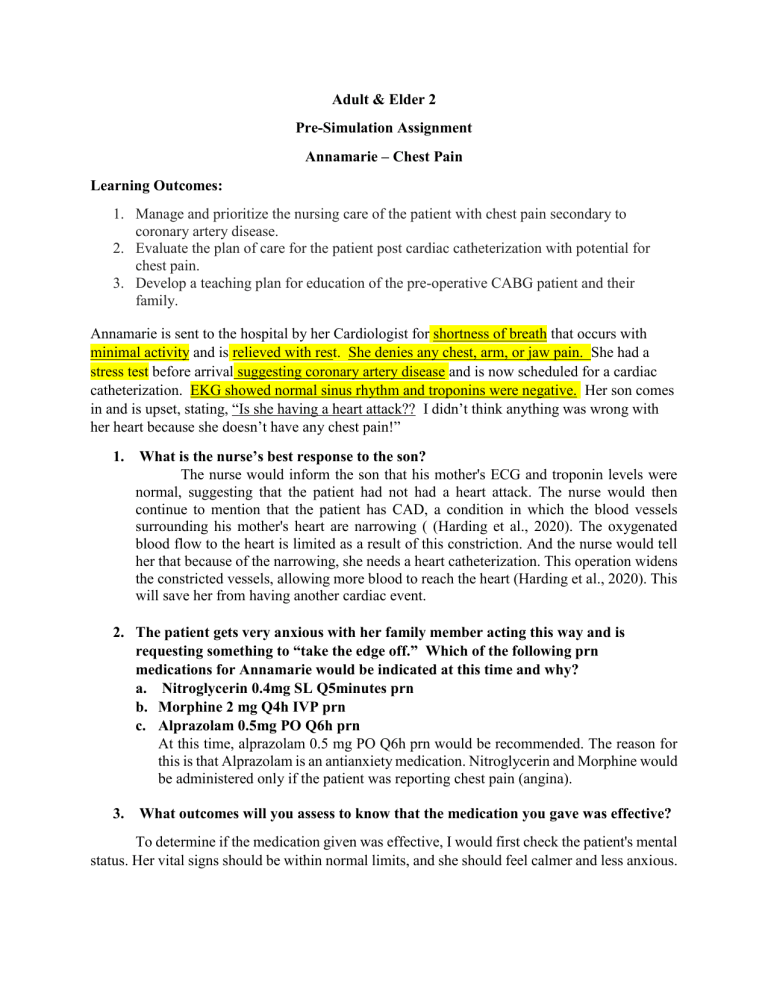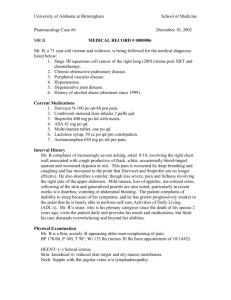
Adult & Elder 2 Pre-Simulation Assignment Annamarie – Chest Pain Learning Outcomes: 1. Manage and prioritize the nursing care of the patient with chest pain secondary to coronary artery disease. 2. Evaluate the plan of care for the patient post cardiac catheterization with potential for chest pain. 3. Develop a teaching plan for education of the pre-operative CABG patient and their family. Annamarie is sent to the hospital by her Cardiologist for shortness of breath that occurs with minimal activity and is relieved with rest. She denies any chest, arm, or jaw pain. She had a stress test before arrival suggesting coronary artery disease and is now scheduled for a cardiac catheterization. EKG showed normal sinus rhythm and troponins were negative. Her son comes in and is upset, stating, “Is she having a heart attack?? I didn’t think anything was wrong with her heart because she doesn’t have any chest pain!” 1. What is the nurse’s best response to the son? The nurse would inform the son that his mother's ECG and troponin levels were normal, suggesting that the patient had not had a heart attack. The nurse would then continue to mention that the patient has CAD, a condition in which the blood vessels surrounding his mother's heart are narrowing ( (Harding et al., 2020). The oxygenated blood flow to the heart is limited as a result of this constriction. And the nurse would tell her that because of the narrowing, she needs a heart catheterization. This operation widens the constricted vessels, allowing more blood to reach the heart (Harding et al., 2020). This will save her from having another cardiac event. 2. The patient gets very anxious with her family member acting this way and is requesting something to “take the edge off.” Which of the following prn medications for Annamarie would be indicated at this time and why? a. Nitroglycerin 0.4mg SL Q5minutes prn b. Morphine 2 mg Q4h IVP prn c. Alprazolam 0.5mg PO Q6h prn At this time, alprazolam 0.5 mg PO Q6h prn would be recommended. The reason for this is that Alprazolam is an antianxiety medication. Nitroglycerin and Morphine would be administered only if the patient was reporting chest pain (angina). 3. What outcomes will you assess to know that the medication you gave was effective? To determine if the medication given was effective, I would first check the patient's mental status. Her vital signs should be within normal limits, and she should feel calmer and less anxious. She may feel tired, lethargic, or dizzy, as these are frequent Alprazolam side effects. She would, however, be monitored for any severe adverse effects (Harding et al., 2020). The patient returns to the unit post-catheterization. Three vessel diseases and poor coronary anatomy prevented stent placement during the catheterization and she is now scheduled for a coronary artery bypass graft tomorrow. Upon return to the unit, you perform a full assessment and complete the vascular assessment form at the bedside. 4. Describe at least three items you will focus on for your assessment of the patient. I would focus on the 5 Ps: pallor (paleness), paralysis (inability to move), parenthesis (tingling), pulselessness (no pulse), and pain, swelling, or bleeding at the insertion site. I would also listen to heart sounds to ensure they were clear and that the catheterization did not disrupt anything. You note a dorsalis pedis pulse of 1+ on the left and 2+ on the right. The left leg is cool and dry, the right leg warm and dry. Capillary refill is >3 seconds on the left and <3 seconds on the right. 5. What findings concern you and why? The difference from left to right is unexpected, indicating a possible DVT in the left leg, which worries me since it reduces blood flow to the extremities and puts the patient in danger of embolism. 6. What is the priority nursing diagnosis based on the findings above? Ineffective tissue perfusion due to thrombus formation would be the primary nursing diagnosis for this patient, as demonstrated by cool and dry skin, a weak dorsalis pedis pulse, and sluggish capillary refill on the left lower extremity. 7. Annamarie has just signed consent for her CABG today. She wants to know if she will be discharged in time for a wedding she is supposed to attend in three days. What education would you provide this patient on the procedure and post op plan? I would inform Annamarie that she will most likely not be discharged in time for the wedding because patients usually stay in the hospital for 3-5 days post-op (P. A. R. M. E. G. Faan et al., 2019). I would advise her that because she is having a significant surgery, she should rest at home for about a week before partaking in social events. I would educate the patient on the purpose of the procedure and what to expect during and after the procedure. I would make sure she is NPO and explain that her medications may change after surgery and that she may be placed on extra medications to prevent further complications (P.A.R.M.E.D. Faan et al., 2019). I would also notify her that she may be expected to have chest tubes, an indwelling urinary catheter, and be placed on a ventilator after surgery. We will be monitoring for markers of complications such as fluid and electrolyte imbalance, hypotension, hypertension, hyperthermia, bleeding, angina, and so on (P.A.R.M.E.D. Faan et al., 2019). She will be educated on how to splint her chest incision while coughing, use a spirometer, and conduct leg and arm exercises (P.A.R.M.E.D. Faan et al., 2019). 8. Identify three activities that the patient can do to promote cardiovascular health promotion and maintenance upon discharge. Annamarie can engage in three activities: aerobic exercise, a healthy cardiac diet, and keeping a blood pressure log. Aerobic exercises, such as walking, jogging, bicycling, and swimming, can help maintain cardiac health by boosting heart rate and increasing oxygen in the blood, resulting in improved blood supply to the muscles (P.A.R.M.E.D. Faan et al., 2019). Maintaining a healthy cardiac diet, such as minimizing salt consumption, saturated fats, and cholesterol, will help prevent new plaque formation in her blood arteries (Perry, Potter & Elkin, 2012). Keeping a blood pressure journal can help you monitor your blood pressure levels and confirm that your medications and lifestyle adjustments are helping to keep them stable. Reference Faan, P. A. R. M. E. G., Faan, P. R. P. P. A., & Cne, O. W. R. M. E. (2019). Nursing Interventions & Clinical Skills (7th ed.) [E-book]. Mosby. Faan, H. D. R. P. A. C. C. A., Cne, F. R. P. M. H. M., Faanp, K. J. D. M. R. A. F., Cne, R. D. R. E. M. M. O. C., & Fnp-Bc, R. C. R. D. (2019). Clinical Companion to Lewis’s Medical-Surgical Nursing: Assessment and Management of Clinical Problems (11th ed.) [E-book]. Mosby.







